What woodpeckers can you see in Austria? There are 9 different species of woodpecker that you might encounter in Austria. Read this article to see pictures, hear their sound and get great information about where and when you can spot all woodpeckers in Austria.
Nestled in the heart of Europe, Austria is a treasure trove of stunning alpine landscapes, enchanting meadows, and dense, whispering forests. But as you traverse these varied terrains, there’s an underlying rhythm that captures the soul—a series of taps, drums, and calls that speak of the country’s vibrant avian life. Among the most charismatic of these are the woodpeckers, nature’s dedicated drummers. In this journey, we’ll delve deep into Austria’s woods and highlands, trailing these fascinating birds and discovering their stories against the backdrop of Austria’s pristine beauty. So, with a sense of wonder, let’s embark on an avian ballet with Austria’s woodpeckers.
Let’s jump into the article.
1. Eurasian Three-toed Woodpecker
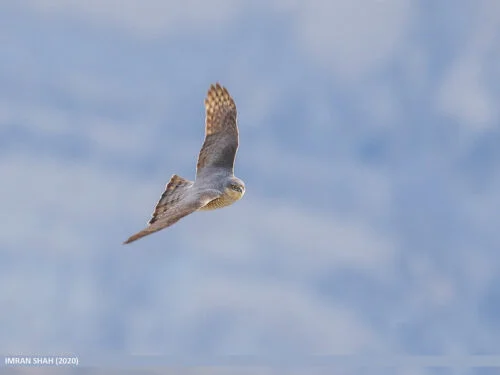
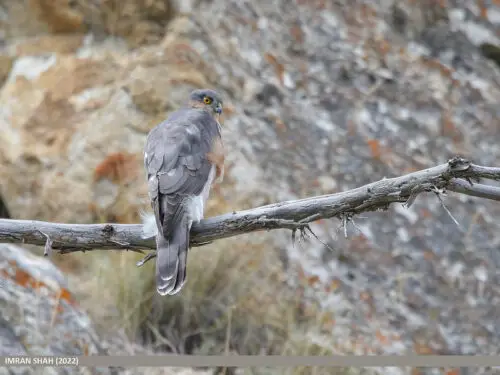
The snow-clad peaks and dense coniferous forests of Austria are home to a particularly elusive artist, the Eurasian Three-toed Woodpecker. A somewhat secretive bird, it’s often identified by its unique drumming before it’s actually seen. Draped in a monochromatic palette, its black and white plumage might seem simple at first glance. However, a closer look reveals a delicate balance of patterns with males sporting a yellow cap, adding a dash of color to their appearance.
These woodpeckers have an affinity for the cold, often found in the alpine forests and mature coniferous woods. Austria’s National Parks, particularly the Gesäuse National Park and the Kalkalpen National Park, are prime habitats where these birds can be spotted, meticulously working on tree trunks or flitting between branches.
What sets the Eurasian Three-toed Woodpecker apart is not just its three toes (most woodpeckers have four), but its specialized diet that primarily consists of bark beetles, making it an essential player in forest ecosystems. Their feeding habits, as they peel away bark in search of these insects, play a crucial role in maintaining the health of Austria’s woodlands.
Austrian folklore reveres the forest and its myriad residents. And while the Eurasian Three-toed Woodpecker might not be as prominent in tales as some of its more colorful cousins, its role in the forest’s life and rhythm is undeniable. For those who trek through Austria’s wilderness with a sense of curiosity, the soft drumming of this bird becomes a guiding rhythm—a heartbeat of the forests that have stood tall and proud for centuries.
2. Middle Spotted Woodpecker
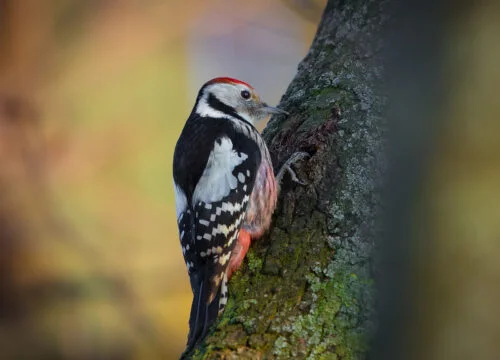
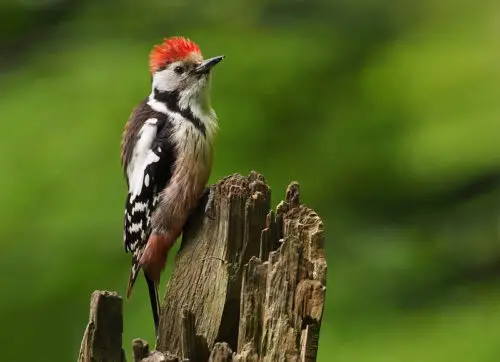
Austria’s vast deciduous woodlands, especially those rich in oak, hornbeam, and birch, often echo with the playful antics of a rather vibrant character: the Middle Spotted Woodpecker. This mid-sized bird, with its unique appearance and spirited behavior, embodies the vivacity of Austria’s thriving woodlands, offering glimpses of nature’s delightful dance.
Decorated with a distinct series of white spots against a black backdrop, the Middle Spotted Woodpecker’s plumage beautifully captures the dappling effect of sunlight filtering through the forest canopy. But the crown jewel of its appearance is its red cap, reminiscent of a royal crest, especially prominent in adults. Younger ones wear a more subdued attire, with their caps taking on a faded red or even brown hue.
In the heart of Austria, particularly regions like the Wienerwald (Vienna Woods) or the Lower Austrian forested landscapes, the Middle Spotted Woodpecker thrives. It adores areas where old trees stand tall, their decaying branches offering a buffet of insects, larvae, and spiders.
Unlike some woodpeckers that drill deep into the bark, the Middle Spotted prefers to forage on the surface, often on thinner branches and twigs. And while insects are its favored cuisine, it won’t say no to a berry or nut, especially when seasons change.
Austrian tales and lore are rich with stories of the forest, where each creature plays a role. The Middle Spotted Woodpecker, with its distinctive drumming and merry calls, has inspired stories of joy, hope, and the cyclical beauty of nature. Its presence, for many, is a reminder of the intricacies of the woodland ecosystem and the harmonious balance that sustains it.
As one treks through Austria’s enchanting forests, a brief sighting of the Middle Spotted Woodpecker, or a chance hearing of its melodic drumming, is like a brush with the very essence of the wild—a testament to the country’s deep-rooted love for nature and its manifold wonders.
3. White-backed Woodpecker
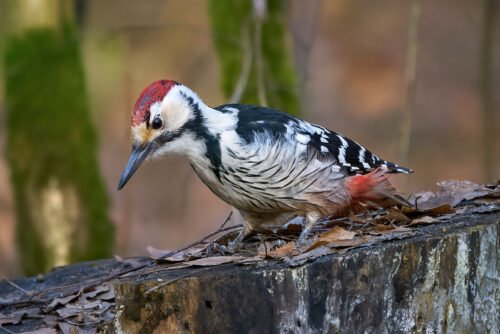
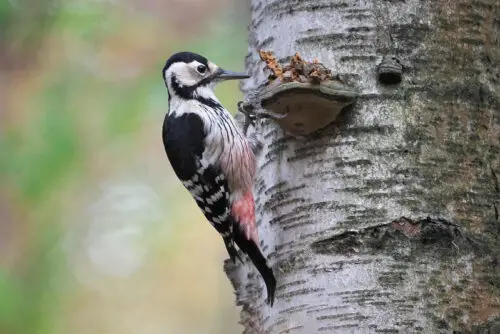
Delving deeper into Austria’s ancient and untouched woodlands, one might be fortunate enough to encounter the elusive White-backed Woodpecker. As the name suggests, this bird boasts a stunning white back, a stark contrast to the more commonly seen black-backed woodpeckers, making it a captivating sight against the verdant Austrian backdrop.
This woodpecker, with its white dorsal feathers neatly framed by black wings speckled with white spots, presents a delightful spectacle. The male further embellishes this look with a vivid red crown, while the female dons a more demure, all-white head.
The White-backed Woodpecker is a denizen of old-growth forests, especially those with a profusion of dead trees and decaying wood. Austria’s primeval forests, particularly in regions like the Nationalpark Gesäuse, offer this bird the perfect habitat. These woodlands provide both the insects they feast upon and the decaying trees they need for nesting.
Renowned for its slightly softer drumming compared to other woodpeckers, the White-backed primarily feeds on wood-boring beetles and their larvae. This diet not only nourishes them but also aids in controlling potential pest populations. The bird’s feeding method is particularly interesting; they often chip away at rotten wood, creating sizable chunks of debris as they search for their next meal.
In the realm of Austrian folklore, old forests are places of magic and mystery. Though the White-backed Woodpecker might not take center stage in many tales, its elusive nature and captivating appearance surely inspire a sense of wonder and respect for the ancient woodlands it calls home.
To wander in the depths of Austria’s forests and chance upon the White-backed Woodpecker is to connect with a world that remains largely untouched by time. It’s a fleeting brush with the wild, a momentary dive into a realm where nature thrives in its purest form, singing its age-old songs, and the White-backed Woodpecker is one of its most melodious voices.
4. Great Spotted Woodpecker
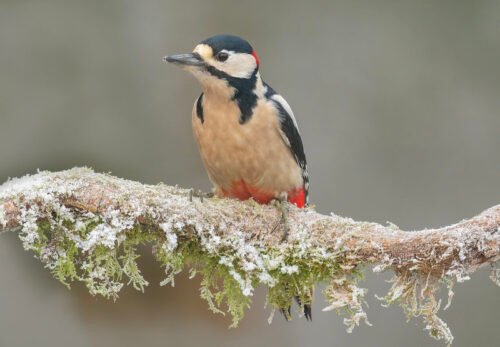
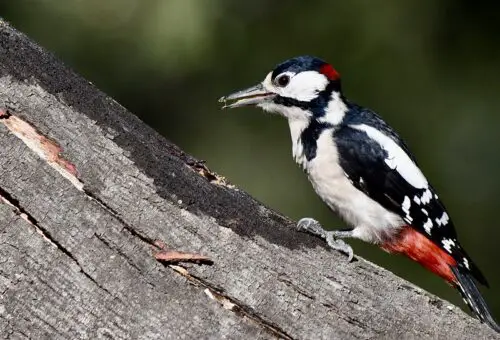
Among the medley of sounds that resonate through Austria’s dense forests, the rhythmical drumming of the Great Spotted Woodpecker is a melody that is both familiar and heartening. This bird, with its striking contrasts and lively demeanor, is a regular feature across Austria, from the verdant valleys of Styria to the snow-kissed alpines of Tyrol.
Draped in a distinctive black and white cloak, the Great Spotted Woodpecker is instantly recognizable. Its back is predominantly black, adorned with large white patches on its wings, and it sports a vividly red underbelly. Adding to its regal appearance, the males wear a brilliant red patch on the back of their heads, while the females stick to a more modest black and white palette. The juveniles, ever the rebels, flaunt a wholly red crown, differentiating themselves from the adults.
One of the most adaptable woodpeckers, the Great Spotted is not particularly fussy about its habitat. Whether it’s a dense forest, a park in Vienna, or even a backyard with enough trees, this bird is happy to set up shop. However, mature forests with a mix of old trees and open spaces are their preferred domains.
Armed with a beak that’s both a chisel and a probe, the Great Spotted Woodpecker drills into tree barks, hunting for beetles, larvae, and spiders. It’s also known to raid nests of other birds, particularly during spring, making them a formidable presence in the avian world. Their distinct drumming, often mistaken for courtship or territorial claims, is also a method to dislodge insects from beneath the bark.
In Austrian culture, the rhythmic tapping of the Great Spotted Woodpecker often signifies the onset of spring or a change in weather. To many, this drumming is the heartbeat of the forest, a reminder of nature’s persistent rhythm amidst the changing seasons.
To witness the Great Spotted Woodpecker in action, flitting from tree to tree with an air of authority and grace, is to experience a fragment of Austria’s rich biodiversity. It’s a dance of life, a symphony of survival, played out against the backdrop of Austria’s timeless landscapes.
5. Lesser Spotted Woodpecker
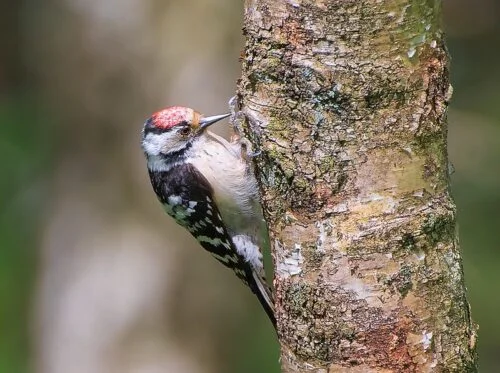
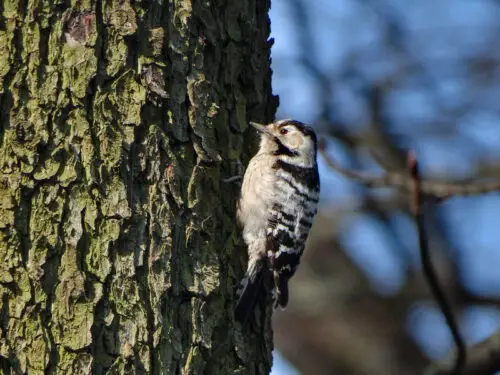
In the dappled sunlight of Austria’s enchanting woodlands, there thrives a diminutive dynamo, the Lesser Spotted Woodpecker. This tiny avian jewel, with its sprightly antics and heartening drumming, resonates with the delicate yet persistent spirit of Austria’s diverse ecosystems.
Don’t let the name ‘lesser’ fool you; while it might refer to the bird’s modest size, there’s nothing small about its presence. The Lesser Spotted Woodpecker is strikingly elegant, wrapped in a graceful combination of black and white feathers. The males are distinguished by a fiery red crown, making them stand out in the dense green of the forests. On the other hand, the females possess a pure white crown, adding to their subdued elegance.
Austria’s deciduous and mixed woodlands, particularly in regions like the Wienerwald (Vienna Woods) and the eastern Steiermark, offer the perfect home for these birds. They’re especially drawn to areas with a good mix of old and young trees, and places where the wood is just beginning to decay. Such environments are rich in their primary diet: insects, spiders, and their larvae.
Unlike their larger relatives, the Lesser Spotted Woodpeckers have a distinctive feeding habit. They often flit around thinner branches and twigs, sometimes even hovering like a hummingbird, to pick off insects from leaves and bark. Their drumming, softer yet persistent, often serves as a delightful background score to Austria’s woodland symphony.
The bird’s presence in Austrian folklore is subtle, akin to whispered tales and old legends. Often portrayed as a symbol of perseverance and the smaller joys of life, the Lesser Spotted Woodpecker is a reminder that nature’s beauty doesn’t always lie in grandeur; sometimes, it’s the small, fleeting moments that leave the deepest impressions.
Walking through the serene trails of Austria’s forests, if you chance upon the soft drumming or the fleeting shadow of the Lesser Spotted Woodpecker, take a moment to pause and appreciate. In its delicate rhythms and swift movements lies the essence of nature: ever-changing, ever-enduring, and endlessly captivating.
6. Grey-headed Woodpecker
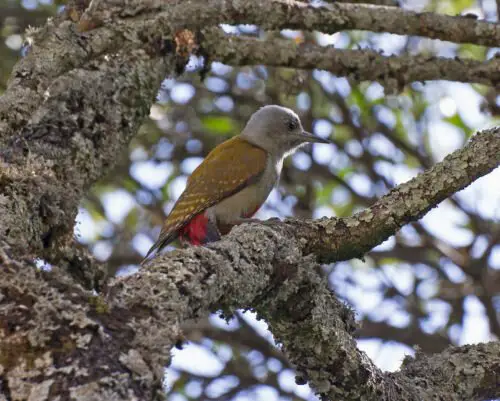
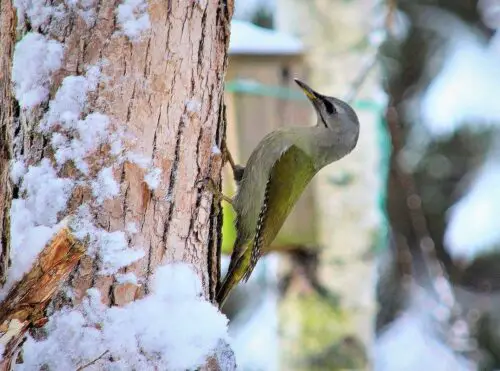
Venture into the heart of Austria’s pristine woodlands and, with a bit of luck, you might hear the gentle, rhythmic drumming of the Grey-headed Woodpecker. This particular avian artist, though less flamboyant than some of its woodpecker cousins, possesses a subdued elegance that is deeply intertwined with the atmospheric forests of the Austrian landscape.
Cloaked in muted tones of grey and green, the Grey-headed Woodpecker exhibits a sophisticated charm. The males feature a soft red patch on the crown, adding just a touch of color to their otherwise monochromatic appearance. Females, in their quiet elegance, don a purely grey head, giving them a serene, almost ethereal presence in the dense woods.
This woodpecker gravitates towards older, deciduous forests interspersed with patches of open land, a characteristic landscape found in regions like the Lower Austrian Forests and the Burgenland. They also occasionally venture into orchards and parks, especially during migratory transitions.
As craftsmen of the forest, Grey-headed Woodpeckers primarily feed on ants, making them somewhat of an anomaly in the woodpecker world. They scour tree barks, forest floors, and even anthills, using their long, sticky tongues to extract these insects. Their drumming, which is more muted compared to other woodpeckers, often acts as an announcement of their presence or as a signal during mating rituals.
In Austrian legends and folktales, the Grey-headed Woodpecker often represents wisdom and introspection, perhaps due to its calm demeanor and muted colors. It’s also seen as a guardian of the forest, helping maintain ecological balance by controlling ant populations.
If you find yourself in the dense, green embrace of Austria’s forests, take a moment to listen. Beyond the rustling leaves and murmuring brooks, you might just catch the gentle drumming of the Grey-headed Woodpecker. And in that sound, you’ll discover the harmonious blend of nature’s rhythms and the enduring legacy of Austria’s rich biodiversity.
7. Eurasian Green Woodpecker
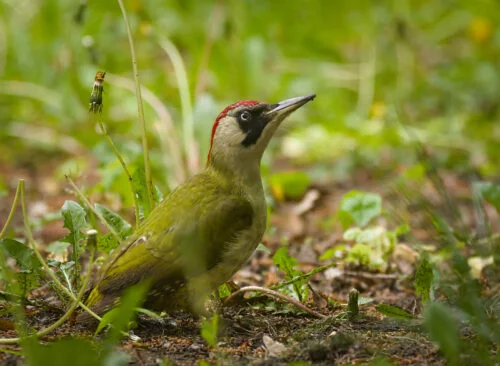
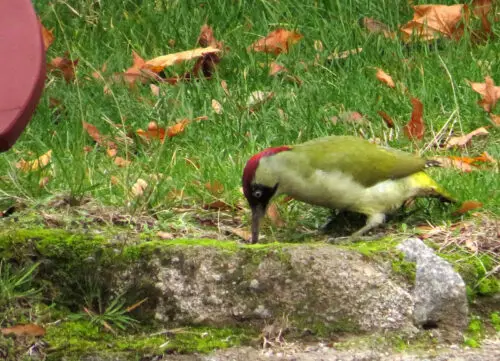
Amidst the timeless tapestry of Austria’s forests, meadows, and alpine scenery, there exists a verdant jewel known as the Eurasian Green Woodpecker. Its vibrant plumage and infectious, laughing call make it one of the most delightful avian residents of this European gem.
Clad in a brilliant shade of green, which seamlessly blends with the dense foliage, the Eurasian Green Woodpecker is an epitome of nature’s artistry. This bird is distinguished by a bright red crown and a jet-black moustachial stripe, setting off its yellowish underparts. While both sexes share the privilege of this rich red crown, only the male sports the additional black moustache tinged with red.
Favoring open woodlands, grasslands, and even city parks, these woodpeckers have a pronounced fondness for areas abundant in ants, their primary diet. From the plains of Lower Austria to the lush landscapes around Salzburg, these birds are a regular sight, using their strong beaks not just for drumming but also for digging into the ground in their quest for ants and their larvae.
Unlike many of its relatives who drum on trees as a form of communication, the Eurasian Green Woodpecker is more often heard than seen, due to its distinct and loud ‘laughing’ call. This signature sound often echoes through the forests, especially during the early spring and late summer months, acting as nature’s very own symphony.
Austrian folklore paints the Eurasian Green Woodpecker in a whimsical light. Local tales often attribute the bird’s laughing call to its role as a harbinger of rain, leading it to be affectionately termed as the “rain bird” in some regions.
If you embark on a journey through Austria’s vast natural expanses, be it the dense woods or the open meadows, attune your ears to the distant laughter of the Eurasian Green Woodpecker. In its cheerful call and vivacious presence, you’ll find a reflection of Austria’s undying love affair with nature and its manifold wonders.
8. Syrian Woodpecker
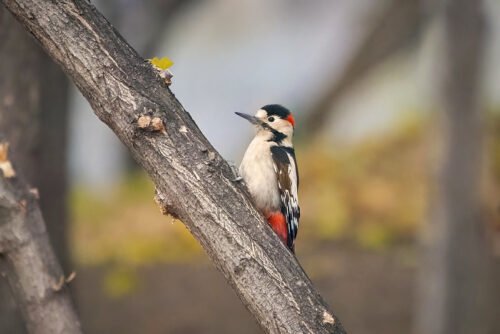

Wandering through the diverse landscapes of Austria, you might stumble upon a somewhat unexpected guest: the Syrian Woodpecker. This bird, native to the more arid regions of southeastern Europe and parts of western Asia, has been making appearances in Austria, adding another note to the country’s rich avian tapestry.
At first glance, the Syrian Woodpecker might be mistaken for its close relative, the Great Spotted Woodpecker. However, upon closer inspection, subtle differences emerge. The Syrian Woodpecker dons a beautiful black and white plumage, but it’s the bird’s vent region that sets it apart, exhibiting a paler rose shade as compared to the vibrant red of its counterpart. The males, ever the show-offs, sport a distinct red crown, while the females embrace a more understated elegance with a plain white face and black nape.
In Austria, this bird is considered a rarity, and spotting one often stirs excitement among birdwatchers and nature enthusiasts. The Syrian Woodpecker’s expansion towards Central Europe, including Austria, is a fascinating tale of adaptation and survival. In Austria, you’re more likely to spot them in the warmer eastern regions, where they find orchards, open woodlands, and even urban areas to their liking.
Adept at carving out nest cavities in trees, the Syrian Woodpecker’s diet is a delightful assortment of insects, especially beetles and their larvae. Their characteristic drumming is not just a mating call but also an effective technique to source their food, as they rattle the wood to disturb and locate hidden insects.
In the world of Austrian avian tales, the Syrian Woodpecker is a relatively new entrant. Its mysterious and unexpected appearances often spark conversations and debates, imbuing the bird with an aura of intrigue and wanderlust. This woodpecker’s journey into Austria’s heartlands serves as a poignant reminder of nature’s resilience and the ever-evolving dance of ecosystems.
For those lucky enough to witness the Syrian Woodpecker amidst Austria’s dense forests or lush meadows, it’s akin to finding a hidden gem—a rare treat that accentuates the beauty and unpredictability of nature’s grand tapestry.
9. Black Woodpecker
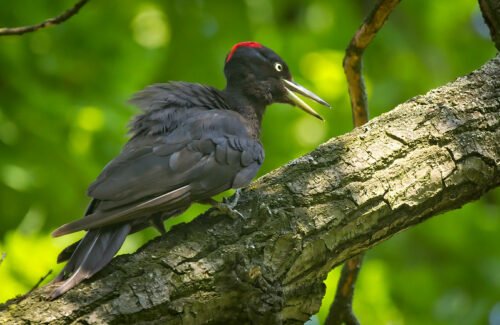
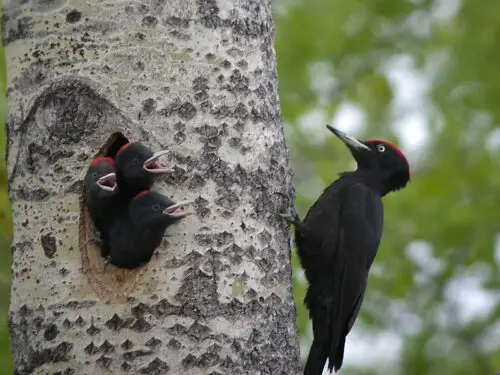
In the heart of Austria’s ancient woodlands, where towering spruces and firs cast their long shadows, a mythical guardian dwells: the Black Woodpecker. This awe-inspiring avian giant, with its pitch-black plumage and resonant drumming, embodies the mystique and grandeur of Austria’s wilderness.
The Black Woodpecker, as the largest of Europe’s woodpeckers, stands out not just in size but also in appearance. Its inky black feathers glisten under the forest canopy, while a vivid red crown adorns the heads of both males and females. The males, however, boast an additional streak of red that extends towards the base of their beak.
These birds hold a special affinity for older coniferous or mixed forests, often found in regions like the Austrian Alps, the dense woodlands of Styria, and the Biosphere Reserve Wienerwald. The Black Woodpecker’s relationship with these forests is symbiotic. While they find nourishment in the larvae of wood-boring beetles, their habit of carving out large nesting holes also benefits various forest dwellers like owls, bats, and other smaller birds.
Their drumming, powerful and deep, can be heard echoing through the woods, signaling territory or simply communicating with a mate. And when they vocalize, their call, a far-carrying, descending “kraa-kraa-kraa”, adds another layer to the forest’s auditory tapestry.
In Austrian folklore, the Black Woodpecker is often revered as a forest sentinel or guardian, its penetrating call warning of changes in the weather or upcoming events. In some tales, its rhythmic drumming is said to be a means of communicating with the spirit world, solidifying its position as a bridge between the tangible and the ethereal.
Should you tread the secluded pathways of Austria’s deep woods, pause, and listen. The drumming of the Black Woodpecker might just reach your ears, reminding you of the enduring mysteries and wonders hidden within the heart of the forest. To encounter this majestic bird is to touch the very soul of Austria’s wilderness – a realm where myth and reality beautifully intertwine.
